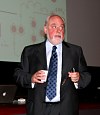 I got a chance to see pioneering supramolecular chemistry supremo, Professor Sir Fraser Stoddart of UCLA on the Cambridge leg of his UK tour on Monday. Sir Fraser took us on a whirlwind tour of the last quarter century of interlocking ring-shaped compounds, molecular dumbbells and the potential of collections of such entities to bring us the next generation of computer memory that could be fast, high density, and even error self-correcting.
I got a chance to see pioneering supramolecular chemistry supremo, Professor Sir Fraser Stoddart of UCLA on the Cambridge leg of his UK tour on Monday. Sir Fraser took us on a whirlwind tour of the last quarter century of interlocking ring-shaped compounds, molecular dumbbells and the potential of collections of such entities to bring us the next generation of computer memory that could be fast, high density, and even error self-correcting.
He also took us on a spin through the synthetic tales of how to make Borromean rings on the molecular scale and ways to tie a Solomon knot with chemistry. It was visually and synthetically beautiful chemistry, told as eloquently and with the same dry wit as the last time I heard him speak. At that time he and his colleagues had designed the ultimate Olympic symbol from four interlocked molecular rings, something the UK’s Olympic designers should have perhaps taken to heart with their publicity materials.
However, aesthetics aside, Sir Fraser’s real take-home message is that chemistry is not yet the mature science many of its number would suggest. Over the last 150 years chemistry has gathered together many words and even begun putting them together into simple phrases, such as Sir Fraser’s own catenanes and rotaxanes. But, this maturity can be likened to the “maturity” of a toddler, he said. It is now time to stop trying to mimic nature with our chemical structures, turn up the complexity by at least an order of magnitude and Make, Measure and Model.